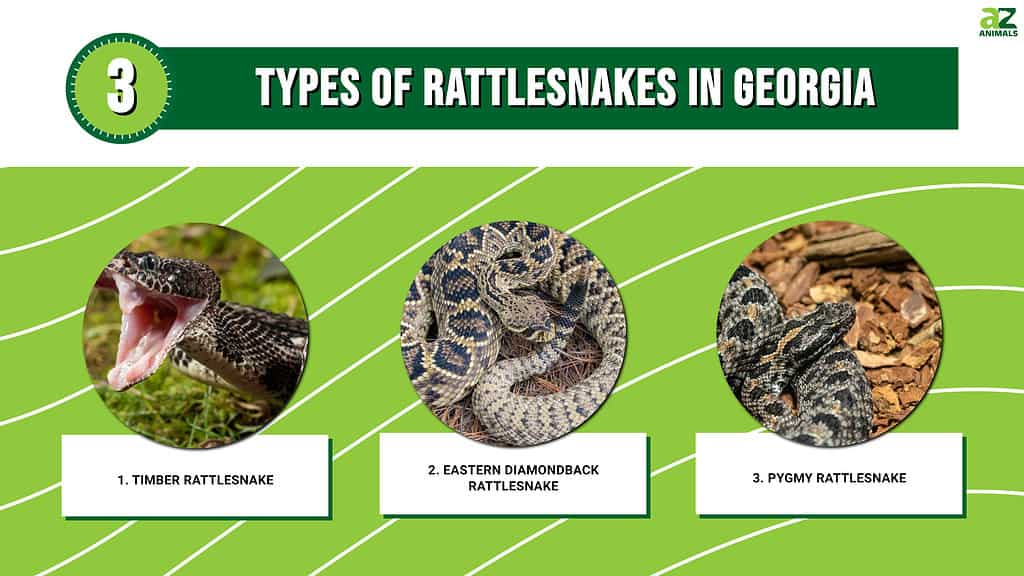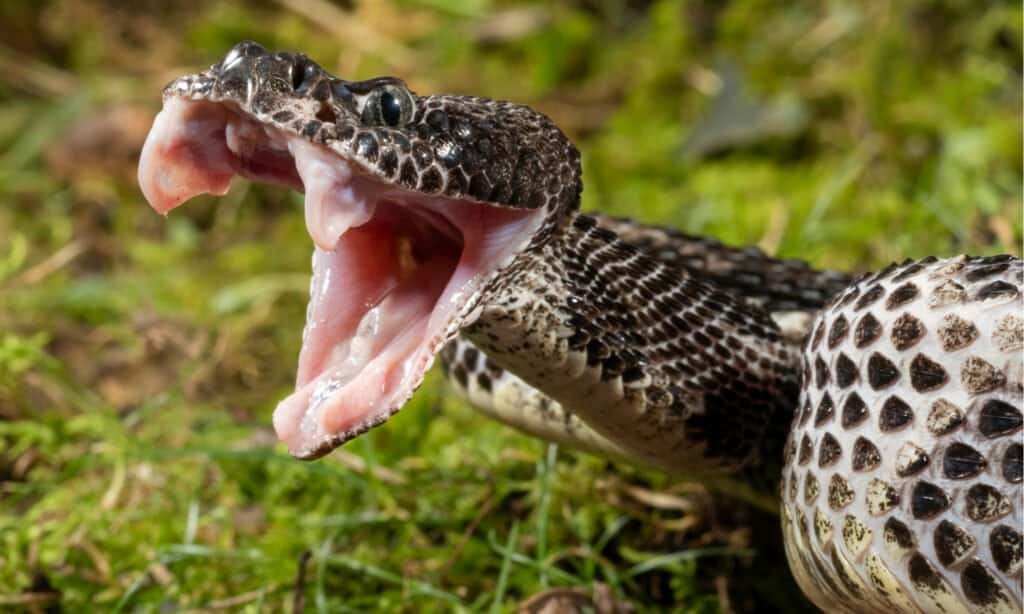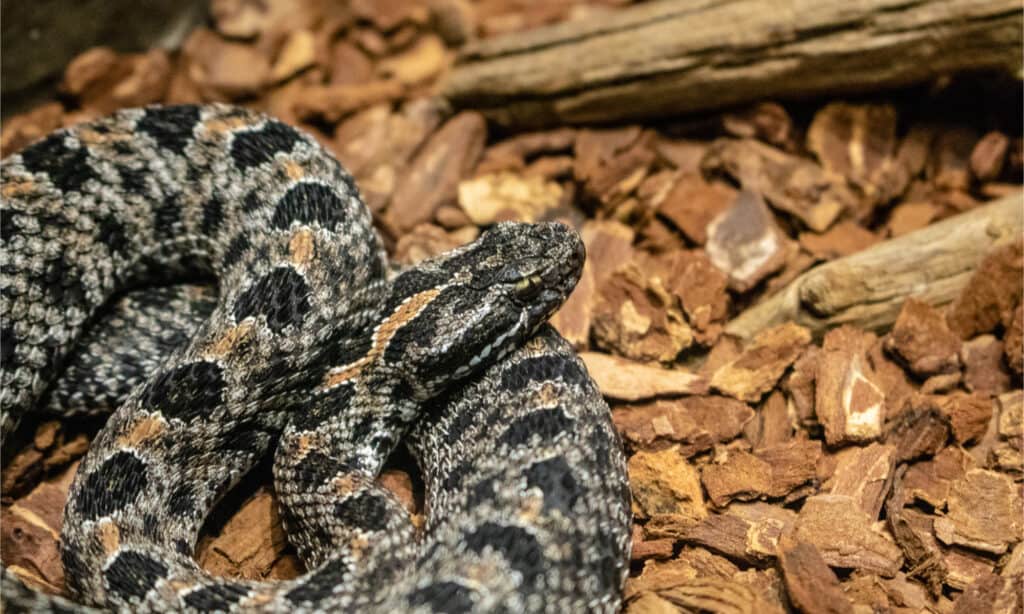The southeastern state of Georgia may be the 8th most populous state in the United States, but it is also full of many natural and untouched wilderness areas. In fact, Georgia is home to 11 different national parks. These natural environments are excellent habitats for many types of snakes, particularly in southern Georgia, where the climate tends to be a bit warmer. There are over 35 different species of snakes in Georgia, ranging in size from 1 foot to over 6 feet in length!

Snakes in Georgia are active from May through to September. You are most likely to encounter snakes here during the summer months when they are on the hunt for food and mates. However, summer days can sometimes be too hot for these cold-blooded animals, so they may only come out in the early morning and at night.
Although most of the snakes in Georgia are harmless, there are six species here that are venomous enough to harm humans. Dangerous snakes in Georgia include coral snakes, cottonmouths, copperheads, and rattlesnakes. However, copperhead snakes are the only really aggressive snakes in Georgia. The other venomous snakes typically avoid humans as much as possible. This is especially true for Georgia’s rattlesnakes. Let’s take a closer look at the 3 types of rattlesnakes in Georgia!
1. Timber Rattlesnake (or Canebrake)

Timber rattlesnakes are among the most venomous snakes in the United States.
©Joe McDonald/Shutterstock.com
| Timber Rattlesnake | |
|---|---|
| Range | All of Georgia |
| Length | 36-60 inches |
The timber rattlesnake lives throughout all of Georgia. In the eastern and southeastern regions, this snake is often called the canebrake rattlesnake. Although it has an extremely toxic venom, the timber rattlesnake is surprisingly calm and rarely attacks humans. It often remains still, using its camouflage colors and patterns to hide among leaves and plants. When threatened, timber rattlesnakes rattle their tails loudly in a warning. They only strike and bite as a very last resort.
Timber rattlesnakes are large and have thick, heavy bodies. These snakes typically range between 36-60 inches in length. However, many timber rattlesnakes have been known to grow much larger, and some have grown over 72 inches long! Timber rattlesnakes are gray or brown with dark chevron-shaped crossbands running down the length of their bodies. The ends of their tails are black and have a segmented rattle that grows in size each time they shed their skin.
In eastern Georgia, timber rattlesnakes (or canebrake rattlesnakes) are often gray with pinkish hues, and they have a brown or orange stripe running down the middle of their backs. In western Georgia, on the other hand, timber rattlesnakes tend to be more brown or yellow instead of pink.
Timber rattlesnakes have extremely toxic venom and large fangs that deliver highly dangerous bites. In fact, they are one of the most dangerous snakes in the United States. However, timber rattlesnakes are generally docile animals and rarely strike. These snakes are excellent pest exterminators. They hunt and eat small mammals, rodents, rats, frogs, and even other snakes.
2. Eastern Diamondback Rattlesnake

Eastern diamondback rattlesnakes’ pattern often fades towards their tail.
©Chase D’animulls/Shutterstock.com
| Eastern Diamondback Rattlesnake | |
|---|---|
| Range | Southern Georgia |
| Length | 33-72 inches |
The eastern diamondback rattlesnake lives in southern Georgia. This snake is not very picky about its habitat but commonly likes sandy woodlands, coastal scrub areas, and dry pine flatwoods. However, eastern diamondback rattlesnakes are very rarely seen in Georgia. These large snakes may look frightening, but in reality, they are actually very shy and avoid humans as much as possible.
These snakes do not attack with aggression but only strike as a defense. Most bites in Georgia occur when a human pesters them or tries to catch them. Although they are not very aggressive, these snakes can be very dangerous. An eastern diamondback rattlesnake can strike up to 1/3 of its body length and has a strong hemotoxic venom. In fact, the eastern diamondback rattlesnake is one of the most dangerous snakes in all of North America.
Eastern diamondback rattlesnakes measure between 33-72 inches. On rare occasions, however, these snakes can grow to be over 85 inches long! The eastern diamondback rattlesnake looks very similar to the western diamondback rattlesnake. However, its colors and patterns are much darker. Eastern diamondback rattlesnakes are easy to identify because of their large bodies and the dark diamond pattern that runs along their backs. They eat small mammals like rats and mice, but they especially like rabbits.
3. Pygmy Rattlesnake

Pygmy rattlesnakes are among the smallest species of rattlesnakes.
©Suzanna Ruby/Shutterstock.com
| Pygmy Rattlesnake | |
|---|---|
| Range | All of Georgia, except Northern Edge |
| Length | 15-20 inches |
The pygmy rattlesnake lives throughout Georgia, except for the northern edge of the state. This snake prefers habitats that are near water sources, like the edges of streams, swamps, marshes, and creeks. However, it is rarely encountered in Georgia because it spends most of its time hidden away from prying eyes. The pygmy rattlesnake often hides under logs, rocks, and among piles of leaves and debris. It also has a very small rattle at the end of its tail that is very hard to hear. Most likely, you will not hear a pygmy rattlesnake’s rattle until you are just a few feet away.
Like their name, pygmy rattlesnakes are a small species, growing only 15-20 inches long. Because of their small size, they do not produce a high level of venom, so their bites are generally not extremely lethal to adult humans. However, their venom is still very toxic and can be fatal to small children and pets. Pygmy rattlesnakes are not typically aggressive and more often choose to flee rather than attack or fight.
Although small, pygmy rattlesnakes have beautiful and vivid colors and patterns. Their bodies are gray or silver with distinct black or reddish-brown spots along the middle of their backs. Additional smaller spots mark both sides of their bodies. There are two different subspecies of the pygmy rattlesnake in Georgia: the dusky pygmy rattlesnake and the Carolina pygmy rattlesnake. Both subspecies are very similar in appearance, but each has a slightly different coloration. The Carolina pygmy rattlesnake, for example, often has pinker or more orange-colored hues. The dusky pygmy rattlesnake, on the other hand, has dark and gray tones.
Summary Of 3 Types Of Rattlesnakes In Georgia
| Rank | Type Of Rattlesnake | Length |
|---|---|---|
| 1 | Timber | 36-60 inches |
| 2 | Eastern Diamondback | 33-72 inches |
| 3 | Pygmy | 15-20 inches |
Discover the "Monster" Snake 5X Bigger than an Anaconda
Every day A-Z Animals sends out some of the most incredible facts in the world from our free newsletter. Want to discover the 10 most beautiful snakes in the world, a "snake island" where you're never more than 3 feet from danger, or a "monster" snake 5X larger than an anaconda? Then sign up right now and you'll start receiving our daily newsletter absolutely free.
Thank you for reading! Have some feedback for us? Contact the AZ Animals editorial team.








